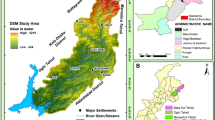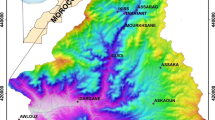Abstract
Extreme precipitation events lead to flash floods, which can trigger soil erosion and landslides. While damages to infrastructure and livelihoods are rapidly assessed on economic terms, damages to natural resources are not estimated due to limited observation record. This study conducted an analysis using remote sensing data to estimate changes in soil erosion rates before, during and after the Kerala 2018 floods, based on the Universal Soil Loss Equation (USLE). The USLE was driven by multiple data including: in situ rainfall data from Indian Meteorological Department (to estimate rainfall erosive factor), soil maps prepared by Food and Agriculture Organization (to estimate the soil erodibility factor from the properties of soil that consists of the percentage of clay, loam and silt), digital elevation model (to estimate topographic slope and length) from Shuttle Radar Topography Mission and multispectral imagery (to estimate cover management factor and conservation practice factor) from Landsat-8 satellite. Data from these sources were analysed using a Geographic Information System (GIS) platform. Results indicate a state-wise average increase of 80% (31–56 metric tons ha−1 year−1) in soil erosion rate during the floods. Of the districts, Idukki showed the highest increase, of 220% and more susceptibility to soil erosion, which is in comparison with government survey records. Results show that the floods and associated erosion were not only due to the rainfall event but also due to the rapid change in land use and land cover, from natural to human settlements. Therefore, government agencies need to protect land cover and reduce unsustainable development in ecologically sensitive environments, which if managed properly can act as a buffer for soil erosion extremes in Kerala.







Similar content being viewed by others
References
Abraham, S. (2015). The relevance of wetland conservation in Kerala. International Journal of Fauna and Biological Studies, 2(3), 01–05.
Alewell, C., Borrelli, P., Meusburger, K., & Panagos, P. (2019). Using the USLE: Chances, challenges and limitations of soil erosion modelling. International Soil and Water Conservation Research, 7(3), 203–225.
Ali, H., & Mishra, V. (2018). Increase in subdaily precipitation extremes in India under 1.5 and 2.0 °C warming worlds. Geophysical Research Letters, 45(14), 6972–6982.
Arnoldus, H. M. (1980). An approximation of the rainfall factor in the Universal Soil Loss Equation. In M. De Boodt & D. Gabriels (Eds.), Assessment of Erosion (pp. 127–132). Chichester, UK: Wiley.
Balagopalan, M. (1995). Soil characteristics in natural forests and Tectona grandis and Anacardium occidentale plantations in Kerala, India. Journal of Tropical Forest Science, 7, 635–644.
Bannari, A., Morin, D., Bonn, F., & Huete, A. R. (1995). A review of vegetation indices. Remote Sensing Reviews, 13(1–2), 95–120.
Bormudoi, A., & Nagai, M. (2016). A remote-sensing-based vegetative technique for flood hazard mitigation of Jiadhal basin, India. Natural Hazards, 83(1), 411–423.
Boyaj, A., Ashok, K., Ghosh, S., Devanand, A., & Dandu, G. (2018). The Chennai extreme rainfall event in 2015: The Bay of Bengal connection. Climate Dynamics, 50(7–8), 2867–2879.
Census of India. (2011). Provisional population totals. New Delhi: Government of India.
Chinnasamy, P. (2017). Inference of basin flood potential using nonlinear hysteresis effect of basin water storage: case study of the Koshi basin. Hydrology Research, 48(6), 1554–1565.
Chinnasamy, P., & Ganapathy, R. (2018). Long-term variations in water storage in Peninsular Malaysia. Journal of Hydroinformatics, 20(5), 1180–1190.
Chinnasamy, P., & Parikh, A. (2020). Remote sensing-based assessment of Coastal Regulation Zones in India: a case study of Mumbai, India. Environment, Development and Sustainability.
Chinnasamy, P., & Sood, A. (2020). Estimation of sediment load for Himalayan Rivers: case study of Kaligandaki in Nepal. Journal of Earth System Science, 129(1).
Chinnasamy, P., Maheshwari, B., & Prathapar, S. A. (2018). Adaptation of Standardised Precipitation Index for understanding watertable fluctuations and groundwater resilience in hard-rock areas of India. Environmental Earth Sciences, 77(15).
Choudhury, M. K., & Nayak, T. (2003). Estimation of soil erosion in Sagar Lake catchment of central India. In International conference on water and environment, 15–18 December 2003, Bhopal, India (pp. 387–392).
Dhar, O. N., & Nandargi, S. (2002). Flood study of the Himalayan tributaries of the Ganga river. Meteorological Applications, 9(1), 63–68.
Evans, J. E., & Seamon, D. E. (1997). A GIS model to calculate sediment yields from a small rural watershed. Erie and Huron Counties, Ohio: Old Woman Creek.
FAO. (2019). Land & Water. Retrieved August 23, 2019, from http://www.fao.org/land-water/land/land-governance/land-resources-planning-toolbox/category/details/en/c/1026564/.
FAO/UNESCO. (1971–1981). Soil map of the world. Legend and 9 volumes. Paris: UNESCO.
Giosan, L., Ponton, C., Usman, M., Glusztajn, J., Fuller, D. Q., Galy, V., et al. (2017). Massive erosion in monsoonal central India linked to late Holocene land cover degradation. Earth Surface Dynamics, 5, 781–789.
GoK (Government of Kerala). (2018). Soil health status of Kerala in post flood scenario. Department of Soil Survey and Soil Conservation, Government of Kerala, Report no. 1455. Kerala, India
Guhathakurta, P., Sreejith, O. P., & Menon, P. A. (2011). Impact of climate change on extreme rainfall events and flood risk in India. Journal of Earth System Science, 120(3), 359.
Gupta, A. K., & Nair, S. S. (2011). Urban floods in Bangalore and Chennai: Risk management challenges and lessons for sustainable urban ecology. Current Science, 100(11), 1638–1645.
IMD - Indian Meteorological Department. (2018). Hydrometeorological services in IMD. Delhi: Government of India.
Jadeja, Y., Maheshwari, B., Packham, R., Hakimuddin Bohra, Purohit, R., Thaker, B., et al. (2018). Managing aquifer recharge and sustaining groundwater use: developing a capacity building program for creating local groundwater champions. Sustainable Water Resources Management, 4(2), 317–329.
Jain, S. K., Agarwal, P. K., & Singh, V. P. (2007). Hydrology and water resources of India (Vol. 57). Berlin: Springer.
Jensen, J. R. (2000). Remote sensing of the environment: An earth resource perspective. Upper Saddle River, NJ: Prentice Hall.
Kumar, A. (2013). Demystifying a Himalayan tragedy: study of 2013 Uttarakhand disaster. Journal of Indian Research (Mewar University), 1, 106–116.
Lacombe, G., Chinnasamy, P., & Nicol, A. (2019). Review of climate change science, knowledge and impacts on water resources in South Asia. Background Paper 1. Washington, DC: World Bank.
Mani, K. (2012). Land use and land cover changes detection using multi temporal satellite data Devikulam Taluk, Idukki district, Kerala. International Journal of Geomatics and Geosciences, 3(1), 157–166.
Meyer, L. D., & Wischmeier, W. H. (1969). Mathematical simulation of the process of soil erosion by water. Transactions of the ASAE, 12(6), 754–758.
Milly, P. C. D., Wetherald, R. T., Dunne, K. A., & Delworth, T. L. (2002). Increasing risk of great floods in a changing climate. Nature, 415(6871), 514.
Mishra, A. K., & Nagaraju, V. (2019). Space-based monitoring of severe flooding of a southern state in India during south-west monsoon season of 2018. Natural Hazards, 97(2), 949–953.
Mishra, V., Aaadhar, S., Shah, H., Kumar, R., Pattanaik, D. R., & Tiwari, A. D. (2018). The Kerala flood of 2018: Combined impact of extreme rainfall and reservoir storage. Hydrology and Earth System Sciences Discussions, 1–13.
Nachtergaele, F., van Velthuizen, H., Verelst, L., Batjes, N. H., Dijkshoorn, K., van Engelen, V. W. P., & Montanarela, L. 2010. The harmonized world soil database. In Proceedings of the 19th world congress of soil science, soil solutions for a changing world, Brisbane, Australia, 1–6 August 2010 (pp. 34–37).
Nair, K. M., Chattopadhyay, S., & Sasidharan, C. K. (1997). Analysis of the environmental impact of the lowland to highland migration in the Western Ghats region. Kerala, Technical report submitted to the Ministry of Environment and Forests. Centre for Earth Science Studies, Government of Kerala, Thiruvananthapuram, India
NASA. (2019). Landsat-8. Retrieved May 30, 2019, https://landsat.gsfc.nasa.gov/landsat-data-continuity-mission/.
Pai, D. S., Sridhar, L., Badwaik, M. R., & Rajeevan, M. (2015). Analysis of the daily rainfall events over India using a new long period (1901–2010) high resolution (0.25 × 0.25) gridded rainfall data set. Climate Dynamics, 45(3–4), 755–776.
Papalexiou, S. M., & Montanari, A. (2019). Global and regional increase of precipitation extremes under global warming. Water Resources Research, 55(6), 4901–4914.
Phinzi, K., & Ngetar, N. S. (2019). The assessment of water-borne erosion at catchment level using GIS-based RUSLE and remote sensing: a review. International Soil and Water Conservation Research, 7(1), 27–46.
Rahaman, S. A., Aruchamy, S., Jegankumar, R., & Ajeez, S. A. (2015). Estimation of annual average soil loss, based on RUSLE model in Kallar watershed, Bhavani Basin, Tamil Nadu, India. ISPRS Annals of Photogrammetry, Remote Sensing and Spatial Information Sciences, II, 2, 207–214.
Ramachandran, R. M., & Reddy, C. S. (2017). Monitoring of deforestation and land use changes (1925–2012) in Idukki district, Kerala, India using remote sensing and GIS. Journal of the Indian Society of Remote Sensing, 45(1), 163–170.
Renard, K. G., Yoder, D. C., Lightle, D. T., & Dabney, S. M. (2011). Universal soil loss equation and revised universal soil loss equation, chap. 8. In R. P. C. Morgan & M. A. Nearing (Eds.), Handbook of erosion modelling (pp. 137–167).
Rouse, J. W., Haas, R. H., Schell, J. A., & Deering, D. W. (1973). Monitoring vegetation systems in the great plains with ERTS. In Third 80 ERTS Symposium, NASA SP-351 (pp. 309–317).
Roy, P. (2009). Detection of land use/land cover change and its impact on soil erosion, using satellite remote sensing and GIS. In Proceedings of international conference on energy and environment (pp. 817–821).
Sankar, G. (2018). Monsoon fury in Kerala—A geo-environmental appraisal. Journal of the Geological Society of India, 92(4), 383–388.
Shrestha, A. B., & Bajracharya, S. R. (2013). Case studies on flash flood risk management in the Himalayas: In support of specific flash flood policies. In International centre for integrated mountain development (ICIMOD).
Thuy, H. T., & Lee, G. (2017). Soil loss vulnerability assessment in the Mekong River basin. Journal of the Korean Geo-Environmental Society, 18(1), 37–47.
Valor, E., & Caselles, V. (1996). Mapping land surface emissivity from NDVI: Application to European, African, and South American areas. Remote Sensing of Environment, 57(3), 167–184.
Varua, M. E., Ward, J., Maheshwari, B., Oza, A., Purohit, R., Hakimuddin, & Chinnasamy, P. (2016). Assisting community management of groundwater: irrigator attitudes in two watersheds in Rajasthan and Gujarat, India. Journal of Hydrology, 537, 171–186.
Vicente, M. L., Navas, A., & Machin, J. (2007). Identifying erosive periods by using RUSLE factors in mountain fields of the Central Spanish Pyrenees. Hydrology and Earth System Sciences.
Vishnu, C. L., Sajinkumar, K. S., Oommen, T., Coffman, R. A., Thrivikramji, K. P., Rani, V. R., et al. (2019). Satellite-based assessment of the August 2018 flood in parts of Kerala, India. Geomatics, Natural Hazards and Risk, 10(1), 758–767.
Williams, J. R. (1978). A sediment graph model based on instantaneous unit sediment graph. Water Resource Research, 14(4), 659–664.
Wischmeier, W. H. (1965). Predicting rainfall erosion losses: A guide to conservation planning. Agricultural handbook (p. 537). Washington, DC: US Department of Agriculture.
Wischmeier, W. H., & Smith, D. D. (1978). Predicting rainfall erosion losses—A guide to conservation planning (No. 537). Department of Agriculture, Science and Education Administration.
Xue, J., & Su, B. (2017). Significant remote sensing vegetation indices: A review of developments and applications. Journal of Sensors. https://doi.org/10.1155/2017/1353691.
Zhang, W., Zhang, Z., Liu, F., Qiao, Z., & Hu, S. (2011). Estimation of the USLE cover and management factor C using satellite remote sensing: A review. In 2011 19th International conference on geoinformatics (pp. 1–5).
Author information
Authors and Affiliations
Corresponding author
Additional information
Publisher's Note
Springer Nature remains neutral with regard to jurisdictional claims in published maps and institutional affiliations.
About this article
Cite this article
Chinnasamy, P., Honap, V.U. & Maske, A.B. Impact of 2018 Kerala Floods on Soil Erosion: Need for Post-Disaster Soil Management. J Indian Soc Remote Sens 48, 1373–1388 (2020). https://doi.org/10.1007/s12524-020-01162-z
Received:
Accepted:
Published:
Issue Date:
DOI: https://doi.org/10.1007/s12524-020-01162-z




